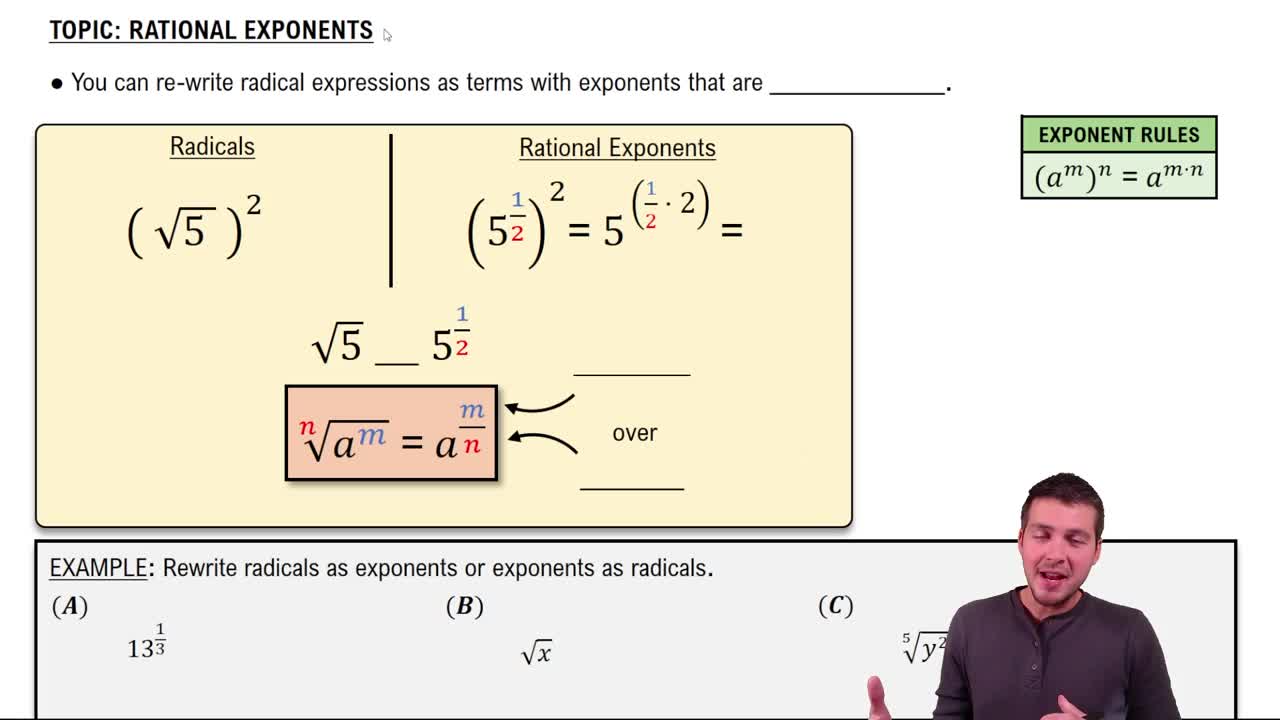Table of contents
- 0. Review of Algebra4h 16m
- 1. Equations & Inequalities3h 18m
- 2. Graphs of Equations43m
- 3. Functions2h 17m
- 4. Polynomial Functions1h 44m
- 5. Rational Functions1h 23m
- 6. Exponential & Logarithmic Functions2h 28m
- 7. Systems of Equations & Matrices4h 6m
- 8. Conic Sections2h 23m
- 9. Sequences, Series, & Induction1h 19m
- 10. Combinatorics & Probability1h 45m
1. Equations & Inequalities
Choosing a Method to Solve Quadratics
Problem 92
Textbook Question
Solve each equation. See Examples 8 and 9. (2x-1)^2/3+2(2x-1)^1/3-3=0
 Verified step by step guidance
Verified step by step guidance1
Let \( u = (2x-1)^{1/3} \). This substitution simplifies the equation to \( u^2 + 2u - 3 = 0 \).
Recognize that \( u^2 + 2u - 3 = 0 \) is a quadratic equation. Factor it to find \( (u + 3)(u - 1) = 0 \).
Set each factor equal to zero: \( u + 3 = 0 \) and \( u - 1 = 0 \). Solve for \( u \) to get \( u = -3 \) and \( u = 1 \).
Substitute back \( u = (2x-1)^{1/3} \) into the solutions for \( u \). This gives two equations: \( (2x-1)^{1/3} = -3 \) and \( (2x-1)^{1/3} = 1 \).
Solve each equation for \( x \): For \( (2x-1)^{1/3} = -3 \), cube both sides to get \( 2x-1 = -27 \). For \( (2x-1)^{1/3} = 1 \), cube both sides to get \( 2x-1 = 1 \). Then solve each resulting linear equation for \( x \).
Recommended similar problem, with video answer:
 Verified Solution
Verified SolutionThis video solution was recommended by our tutors as helpful for the problem above
Video duration:
6mPlay a video:
Was this helpful?
Key Concepts
Here are the essential concepts you must grasp in order to answer the question correctly.
Exponents and Radicals
Exponents represent repeated multiplication of a base number, while radicals involve roots of numbers. In the given equation, the term (2x-1) is raised to the power of 2/3, indicating both squaring and taking the cube root. Understanding how to manipulate these expressions is crucial for solving the equation.
Recommended video:
Guided course

Rational Exponents
Substitution Method
The substitution method involves replacing a complex expression with a simpler variable to make solving easier. In this case, letting y = (2x-1)^(1/3) simplifies the equation significantly, transforming it into a polynomial form that is easier to solve.
Recommended video:

Choosing a Method to Solve Quadratics
Polynomial Equations
Polynomial equations are mathematical expressions that involve variables raised to whole number powers. The equation derived from the substitution will be a polynomial, which can be solved using techniques such as factoring, the quadratic formula, or numerical methods, depending on its degree.
Recommended video:
Guided course

Introduction to Polynomials

 4:03m
4:03mWatch next
Master Choosing a Method to Solve Quadratics with a bite sized video explanation from Callie
Start learningRelated Videos
Related Practice
